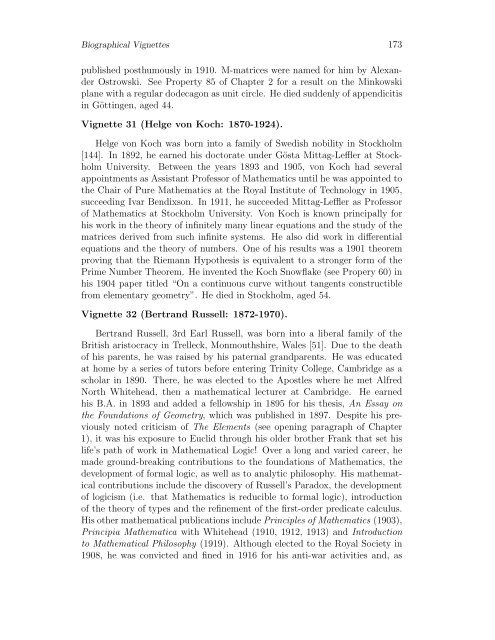MYSTERIES OF THE EQUILATERAL TRIANGLE - HIKARI Ltd
MYSTERIES OF THE EQUILATERAL TRIANGLE - HIKARI Ltd
MYSTERIES OF THE EQUILATERAL TRIANGLE - HIKARI Ltd
You also want an ePaper? Increase the reach of your titles
YUMPU automatically turns print PDFs into web optimized ePapers that Google loves.
Biographical Vignettes 173<br />
published posthumously in 1910. M-matrices were named for him by Alexander<br />
Ostrowski. See Property 85 of Chapter 2 for a result on the Minkowski<br />
plane with a regular dodecagon as unit circle. He died suddenly of appendicitis<br />
in Göttingen, aged 44.<br />
Vignette 31 (Helge von Koch: 1870-1924).<br />
Helge von Koch was born into a family of Swedish nobility in Stockholm<br />
[144]. In 1892, he earned his doctorate under Gösta Mittag-Leffler at Stockholm<br />
University. Between the years 1893 and 1905, von Koch had several<br />
appointments as Assistant Professor of Mathematics until he was appointed to<br />
the Chair of Pure Mathematics at the Royal Institute of Technology in 1905,<br />
succeeding Ivar Bendixson. In 1911, he succeeded Mittag-Leffler as Professor<br />
of Mathematics at Stockholm University. Von Koch is known principally for<br />
his work in the theory of infinitely many linear equations and the study of the<br />
matrices derived from such infinite systems. He also did work in differential<br />
equations and the theory of numbers. One of his results was a 1901 theorem<br />
proving that the Riemann Hypothesis is equivalent to a stronger form of the<br />
Prime Number Theorem. He invented the Koch Snowflake (see Propery 60) in<br />
his 1904 paper titled “On a continuous curve without tangents constructible<br />
from elementary geometry”. He died in Stockholm, aged 54.<br />
Vignette 32 (Bertrand Russell: 1872-1970).<br />
Bertrand Russell, 3rd Earl Russell, was born into a liberal family of the<br />
British aristocracy in Trelleck, Monmouthshire, Wales [51]. Due to the death<br />
of his parents, he was raised by his paternal grandparents. He was educated<br />
at home by a series of tutors before entering Trinity College, Cambridge as a<br />
scholar in 1890. There, he was elected to the Apostles where he met Alfred<br />
North Whitehead, then a mathematical lecturer at Cambridge. He earned<br />
his B.A. in 1893 and added a fellowship in 1895 for his thesis, An Essay on<br />
the Foundations of Geometry, which was published in 1897. Despite his previously<br />
noted criticism of The Elements (see opening paragraph of Chapter<br />
1), it was his exposure to Euclid through his older brother Frank that set his<br />
life’s path of work in Mathematical Logic! Over a long and varied career, he<br />
made ground-breaking contributions to the foundations of Mathematics, the<br />
development of formal logic, as well as to analytic philosophy. His mathematical<br />
contributions include the discovery of Russell’s Paradox, the development<br />
of logicism (i.e. that Mathematics is reducible to formal logic), introduction<br />
of the theory of types and the refinement of the first-order predicate calculus.<br />
His other mathematical publications include Principles of Mathematics (1903),<br />
Principia Mathematica with Whitehead (1910, 1912, 1913) and Introduction<br />
to Mathematical Philosophy (1919). Although elected to the Royal Society in<br />
1908, he was convicted and fined in 1916 for his anti-war activities and, as

















